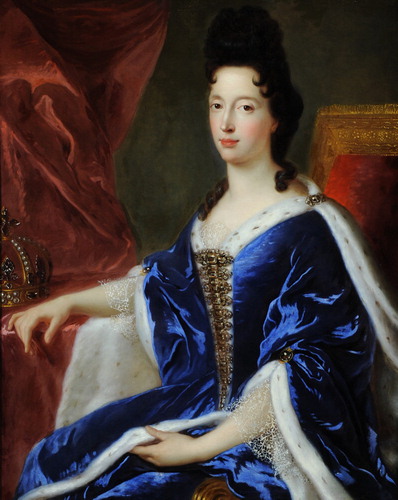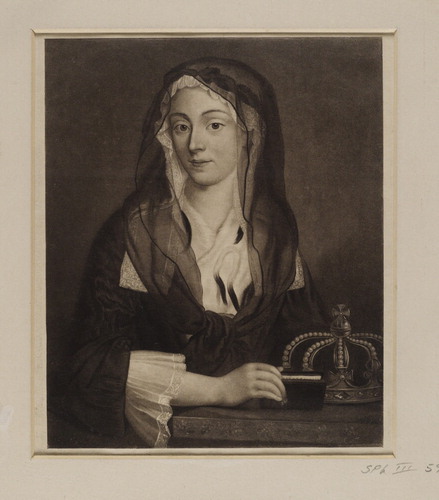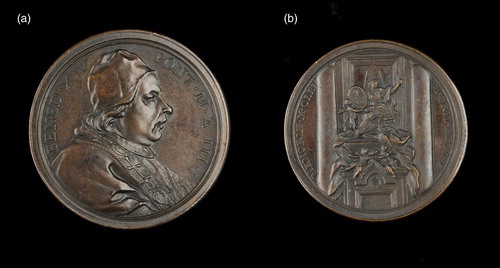Abstract
Tracing its manifestation across three phases in her biography — marriage, separation and funeral — this article considers the image of Maria Clementina Sobieska (1702–35). Examining the objects and portraits which surrounded Clementina’s life and death offers a new historiography for the Jacobite queen in exile. It reinstates her place not only in Stuart and Jacobite history, but in the history of early modern European monarchy and queenship. Supported by documentary sources in the Stuart Papers at Windsor, it will be argued that the Stuart court in exile, their supporters and, importantly, Clementina herself, successfully fashioned for the Stuart consort an image which identified her as an early modern queen. Doing so supported the status of her marital dynasty as exiled royals. However, her image was not singular and it could be manipulated to meet the needs of personal and political agendas, beyond explicitly Jacobite ones.
In 1718, Maria Clementina Sobieska (18 July 1702–18 January 1735), a Polish princess, was selected as bride for James Francis Edward Stuart, or James VIII/III, the exiled king of England, Scotland and Ireland. Despite her status as Stuart queen in exile, Clementina — alongside women more generally — has been under-studied in the Jacobite historiography. This article seeks to reinstate Clementina Sobieska into the narrative of Jacobitism, and early modern queenship more broadly. Bringing together evidence from extant objects and portraits, supported by written records of her life in the Stuart Papers (the letters and accounts of the exiled court, now held in the Royal Collections at Windsor), this research discusses how the material and visual culture surrounding Clementina was harnessed to make her identifiable as a queen. That identity was not singular, however. Considering Maria Clementina Sobieska’s image in three stages — the period surrounding her marriage, the separation from her husband between 1725–27 and her death and afterlife from 1735 — it becomes evident that there were several manifestations of Clementina’s queenship. The image(s) created around Clementina utilised an existing visual language required to meet the expectations of her audiences. Through a successful reading of that image, certain virtues could be identified in it, and therefore as part of Clementina’s self, to validate her royal status and elicit a loyal response. These were variously favoured, manipulated and appropriated by the Stuarts, their supporters and, most importantly, Clementina herself, to meet the needs of their personal and political agendas.
Although there were variations in how the Queen could be represented to best suit her agenda and that of her supporters, throughout her life and in death, Clementina was identified with a model of early modern queenship common to her ruling contemporaries. It can usefully be called ‘Baroque’ queenship. Here, Baroque denotes the court culture specific to European monarchies during the seventeenth and eighteenth centuries, which was ‘designed to project the ruler and consort on a heroic scale’ and can be associated with absolute monarchy and Catholicism in particular.Footnote1 It should also be noted that Clementina’s experience was one of a queen consort. Consorts derived their position and power from their husbands, sons and their natal dynasties, rather than their own person. Yet, their public image was central to maintaining the authority and legitimacy of the ruling court. As Helen Watanabe-O’Kelly has argued, ‘the life of a consort was a public performance’, acted out in accordance with a script.Footnote2 By doing so successfully, queens consort fulfilled an ‘essential dynastic role’.
The primary function of the queen consort was to produce heirs, guaranteeing the longevity of the dynasty and with it, peace and stability. It has been argued that the main considerations when choosing a consort were her dynastic lineage, political associations, and ‘confessional acceptability’.Footnote3 As a dynastic and cultural bridge between her natal and marital states, the consort contributed to international politics.Footnote4 She would ideally bring wealth to the marriage, and use it to display an appropriate ‘opulent level of majesty’ on behalf of her marital dynasty.Footnote5 Queens were also often required to sustain the religious agenda of the court, devoting time to religious observance, charitable activities and acting as patrons to religious institutions.Footnote6 Overall, she was expected to perform as a ‘pillar of the realm’ alongside the king, projecting the virtues of modesty, obedience, charity and piety to balance his role in warfare, authority and the dispensation of justice.Footnote7 With such a model in place, we turn to consider how Clementina, as the queen of an exiled court, compared in the wider arena of Baroque queenship.
Marriage and Court Image
In 1717, the exiled Stuart claimant, James VIII/III, was almost thirty years old and unmarried, a pressing issue for his supporters and advisors. Captain Charles Wogan, an Irish Jacobite soldier who had fought at Preston in the 1715 rising, then escaped from imprisonment in the Tower of London, was tasked with finding a suitable bride for James. In February 1718 he arrived at Ohlau (Oława), the court of Prince James Sobieski, son of King John III of Poland — but not elected to succeed his father as monarch himself — and Hedwig Elizabeth of Neuburg. During his visit, Wogan wrote letters to the duke of Mar, at that time Jacobite Secretary of State, providing descriptions of the court and the Sobieski princesses. From these accounts, the decision was made that the youngest daughter, Maria Clementina, would be a suitable bride for James. Wogan wrote: ‘Her features are rather genteel’ with ‘light brown hair, very pretty black eyes [and] a good shape’; her character he considered ‘very devout and [with] no manner of airs’; and at fifteen years old, Clementina’s reproductive potential was assessed as being ‘already fit for [all] the purposes of marriage, though an addition to her size would be very [de]sirable’.Footnote8 Furthermore, Clementina’s relations, including the Holy Roman emperor and the queen of Spain, would tie the Stuarts to some of the most significant royal houses in Europe. Clementina’s grandfather, King John III Sobieski of Poland, was celebrated as the protector of Christian Europe after he defeated the Ottoman army at the Battle of Vienna in 1683. As such, her illustrious bloodline would add to the religious heritage of the exiled Stuart dynasty. A generous dowry made Clementina all the more attractive. This union was also desirable to the Sobieskis, who, it is evident, had discussed the marriage and aspired to the status it would bring them if James succeeded in regaining his crown: Wogan reported that even before his arrival Clementina was affectionately referred to as the queen of England within their court. The young princess was considered an appropriate match and by the end of July 1718 the marriage agreement had been drawn up.Footnote9
The beginning of Clementina’s life as a Stuart was immediately surrounded in drama. While traveling to join the court at Rome in September 1718, her party was arrested and detained at Innsbruck at the command of Emperor Charles VI who, as an ally of King George I, was under pressure to prevent the marriage of ‘the Pretender’. After failed attempts at diplomacy, Wogan was called on once more to rescue the Princess. In April 1719, he succeeded in smuggling Clementina out of her prison, Schloss Ambras, and conducted a furious journey through dangerous terrain to reach Bologna, where James and Clementina were married by proxy. The event attracted significant public attention at the time and has remained one of the main points of interest in Clementina’s life for historians.Footnote10 Pope Clement XI, in the absence of James — who was in Spain as part of the failed 1719 invasion attempt — commissioned Ottone Hamerani to produce a medal celebrating the escape (a and b). Medals had long served to mark significant events in the lives of the exiled Stuarts and to spread the news amongst their supporters in Britain and Rome. On the obverse is a bust of Clementina and inscription of her royal titles, a declaration of her claim through marriage to the thrones of ‘Britain, France and Ireland’. The reverse tells the story of the escape. Clementina is depicted driving a biga, a roman two-horse chariot, towards Rome in the distance. A putto rides with her, representing the love which propelled her to act in this way. One Latin inscription reads ‘the guards being deceived, 1719’.Footnote11 This explains how Clementina escaped from Innsbruck: Wogan’s plan to substitute the Princess with a maid, Jeanneton, succeeded, and Clementina left the palace dressed in a servant’s cloak, unnoticed. The other inscription reads ‘I follow his fortune and his cause’.Footnote12 It may be assumed that the ‘his’ refers to James VIII/III. Clementina’s escape was interpreted as proof of her loyalty to her husband and the Stuart cause. Considering a queen consort’s role as an example to her people, this medal prompts the viewer to similarly ‘follow his fortunes’, remain loyal to their king and act bravely when required to further the cause.
Figure 1a and 1b. Medal commemorating the Flight of Princes Clementina Sobieski from Innsbruck, by Ottone Hamerani, 1719 (National Museums Scotland)
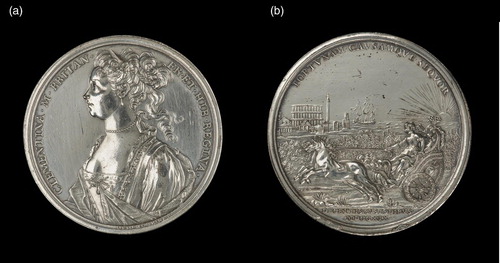
To fully understand this object, we must remember that it was produced by the Papacy. A further layer of meaning is added to the medal by Clement XI’s own reasons for commissioning it in support of the Stuarts: the potential for a Catholic restoration in Britain. In another interpretation, ‘his’ might instead refer to God, transforming the phrase to emphasise that Clementina’s actions were made as a result of her conviction to fulfil the will of God and that the success of the escape was divine providence.Footnote13 There is an expectation that as queen consort Clementina would further the cause of Christianity, and Catholicism in Britain more specifically. Like Queen Caroline (1683–1737), who was presented to Britain as a Protestant heroine in light of her refusal to change her religion to marry the future Holy Roman emperor, Clementina was, for the Stuarts and their papal sponsors, a Catholic heroine.Footnote14 Overall, this medal introduced Clementina to her new subjects and supporters as an example of loyalty and obedience to king and God.
This medal falls into the category of objects produced by the Stuart court, with the assistance of the Papacy, to identify Clementina as a queen. They were used alongside oil-on-canvas portraits, and their more widely circulated engraved and miniature copies, to disseminate the Queen’s image beyond those who met her in person at the exiled court in Rome. Two examples explain how Clementina’s court portraiture followed convention and identified her as an early modern queen. As Joanna Woodall has discussed with reference to Habsburg portraits of Mary Tudor, the ‘iconographic traditions in portraiture were an important means of characterisation’.Footnote15 The ‘iconographic formula’ created around Clementina by the exiled Stuart court not only allowed her to be recognised as a queen but characterised her as a legitimate and worthy one.
The first official portrait of Clementina to reach Britain was painted by Antonio David in 1719 and engraved copies were made in Paris by Pierre Drevet in 1720 (). In this half-length portrait, a youthful Clementina is shown standing next to a table, her hand resting on it, next to an imperial crown. She wears a heavily decorated brocade gown, embellished with pearls and jewels, another string of pearls in her hair, and a cloak of ermine around her shoulders. These rich materials would have been identified by contemporaries as ‘materials of magnificence’. Coined by Griffey in her 2015 study of Henrietta Maria, queen of England, Scotland and Ireland, the term has been useful to understand the type of material display harnessed by Baroque monarchs to cultivate a certain identity and through it, assert their authority. Griffey argues that ‘negotiation around magnificent court display … was central to the monarch’s claiming, justifying and maintaining power’.Footnote16 Portraying Clementina in magnificent clothing, jewels, and royal insignia such as crowns indicated — and in the context of Stuart exile, claimed — her rank and role in society as queen consort. In practical terms, Clementina’s bejewelled body displayed the considerable wealth she brought to the Stuart dynasty, through her dowry and inheritance. Following early modern conventions of representation, the material value, and beauty, of the Queen’s adorned body also signified her inner ‘worth’.Footnote17 Speaking in terms common to representations of contemporary ruling monarchies, the iconography reinforced Clementina’s characterisation as an individual with inherited and acquired (through marriage to the King) superiority in rank and morals.Footnote18
Figure 2 Clementina Sobieska, engraving after Antonio David by Pierre Drevet. (National Library of Scotland)
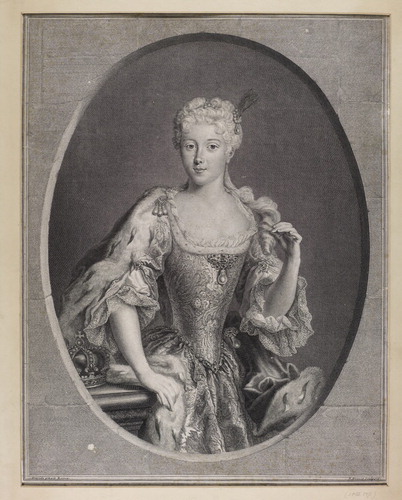
The second example is a half-length portrait, produced posthumously in 1737 by Francesco Trevisani and engraved in London by John Faber Jr. (). It may have used David’s 1722 portrait of Clementina in coronation robes as inspiration.Footnote19 Dressed in the coronation robes of the English monarchy, Clementina is shown with a crown behind her. She holds a white rose, a symbol of the Stuarts and queenship more generally. This portrait claimed for Clementina the legitimacy that a coronation ceremony, with its ritual and spectacle, gave queen consorts. Furthermore, it bears striking similarities to a portrait painted of Mary of Modena in her coronation robes (.). The details of the robes match closely — one copy of the painting in a private collection depicts Clementina’s dress as blue — and in a break from her usual appearance, Clementina’s hair has been left un-powdered, like Mary’s.Footnote20 These similarities present Clementina as the legitimate successor to a crowned Stuart queen consort. Indeed, both portraits of Clementina have parallels with the court portraits of contemporary and preceding queens consort, British and European. They are most notable in the setting (inside a palatial room with draping behind), dress, adornment, the use of royal iconography and pose of the sitter. Sharing an iconographic formula with contemporary queens and royal predecessors, Clementina is situated in what Woodall has termed a ‘visual genealogy’.Footnote21 This not only allowed Clementina, as the consort of an exiled king, to be identified as one of their number, but infused her with their legacy and legitimacy. Her character as a worthy queen was visually explained and justified through her association with these ruling queens.
Figure 3 Clementina Sobieska, engraving after Francesco Trevisani by John Faber Jr. (National Portrait Gallery, London)
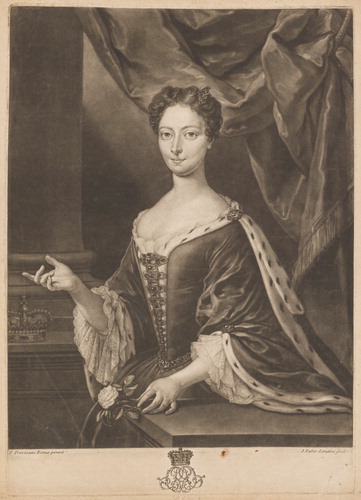
The material culture surrounding Clementina’s early stages as queen consort may suggest that she was ‘an instrument manipulated by others’.Footnote22 The creation and circulation of Clementina’s image as royal queen bolstered the wider Stuart court and dynasty’s claim to legitimacy. Arguably, it is not in-spite of, but because of their uncertain and contested position as exiles that James VIII/III and his court made so much effort to follow precedent in their depictions of their queen consort. To suggest however, that Clementina had no input in the production of her courtly image would be false. The Stuart court account book for 1716–22 is full of purchases made by Clementina of items which are considered as ‘materials of magnificence’ and would have contributed to her identification as a Baroque queen.Footnote23 These include luxurious fabrics such as velvet and finest Belgian lace; regular expenses for new shoes and mittens; numerous instances of costs for mounting fans; and expenses for resetting and ‘brillianting’ jewels. Notably, the accounts reveal that Clementina herself was directly involved in distributing the medals which contained her court image. For October 1720 they record the expense of three medals ‘call’d for by ye Queen’.Footnote24 Furthermore, in May 1721 payment of four scudi was made for a silver medal given by Clementina to ‘David ye Painter’.Footnote25 This gift must be interpreted as a mark of favour for Antonio David, which suggests Clementina was pleased with the portraits he produced of her. Rather than merely being the passive subject of medals and portraits distributed by the court on her behalf, Clementina was actively involved in the production of the image which identified her with the court’s version of queenship. However, in 1725 the exiled Stuart court was disrupted by a split in the royal household and, as the next section demonstrates, Clementina fashioned for herself an alternative model of queenship.
Separation and Self-fashioning
In March 1725, Clementina gave birth to her second child, Henry Benedict, duke of York. Instead of rejoicing however, the event sparked a period of division within the exiled court. Due to the requirements for staffing that another child placed on the court, it was decided by James against Clementina’s will that Prince Charles, at four years old, would be taken out of the care of women and placed under the guardianship of male tutors.Footnote26 Clementina disliked the choice of Charles’s governor, James Murray, Jacobite earl of Dunbar, and in continuation of the disagreement, she demanded that Murray, his sister Marjory and her husband the earl of Inverness be dismissed from court. James refused and, on 15 November 1725, Clementina, assisted by her companion Lady Southesk, removed herself from the court and went to live in the Convent of Santa Cecilia in Trastevere where she remained until July 1727.Footnote27
Those historians who have used the event as evidence of Clementina’s ‘bigoted’ religious views and ‘hysterical temperament’ represent the Whiggish historical tradition which surrounds the history of Clementina Sobieska.Footnote28 Through deeper understanding of the events leading up to and surrounding the separation, it has been argued that while religion was a concern for Clementina, the argument revolved around her place and influence at court. As Aneta Markuszewska has found through analysing the correspondence between Clementina and her father, in the few years before 1725 Clementina had expressed feelings of marginalisation at court, especially at the hands of James and his favourites.Footnote29 As queen consort, Clementina expected to have more influence at court, to participate in decision making, at the least within her own household. However, she was refused both, as James wanted to be ‘master of [his] affairs, and in [his] household’.Footnote30 Rather than being a hysterical response to a minor problem motivated by religious intolerance, in removing herself from the court, Clementina was acting as a wronged queen using the power of her absence to assert herself.
Having played the part in the ‘script’ written for her as a new queen consort, from the separation until her death in 1735, Clementina used cultural patronage to fashion for herself an alternative form of queenship. This was one which focussed more heavily on her personal religion. While it was not the image favoured by her husband, Clementina’s self-identification remained firmly within the expected parameters of Baroque queenship. As Jennifer Germann argues with reference to Marie Leszczinska (1703–58), queen of France, through patronage, queens consort could create their own version of queenship which ‘draws on different discourses and images, complicating [their] identity as queen’.Footnote31 While resident in the convent, in 1726 Clementina commissioned a new portrait of herself from Antonio David (). In this half-length portrait, Clementina is painted wearing plain, dark clothing, with a cap covering her hair and a black veil over her head. Unlike the court portraits, Clementina is not adorned with any jewels. She sits at a table with her finger keeping place in a book — a breviary — as if she has only paused her reading to look out at the viewer. Nun-like, the image emphasises Clementina’s piety.
Despite this change in appearance, Clementina’s royalty is not omitted. The portrait includes symbols appropriate to her royal status: ermine around her neck and, placed prominently at the front of the painting, a closed crown. The sombre, pious, image of queenship created in this portrait had precedent. As widows, two other Stuart queens in exile, Henrietta Maria and Mary of Modena, had cultivated a similar nun-like image to display their role as chief mourners for their husband and devotees to their faith. It presented them as ‘chaste’ and ‘humble’ women, while maintaining the often-increased political agency they gained as widows.Footnote32 Notably however, Clementina was not a widowed queen. Having produced two male heirs for the dynasty, and in the context of her separation from the court, Clementina’s self-fashioned version of queenship as a sort of royal-nun made for a powerful statement of her claim to autonomy.
Despite the more sombre image of Clementina’s self-fashioning, from her accounts in the Stuart Papers — which from 1727 are listed independently to those of James as she was granted her own household upon her return to court — it is evident that Clementina continued to cultivate her image and identity through conspicuous consumption associated with the construction of magnificence. She regularly bought items for herself relating to her religious devotion. Books and prints of Saint Francis de Sales, the veneration of whom she shared with her Stuart predecessors; a rosary made of ‘oriental’ jasper; and silver reliquaries are amongst the items in her accounts.Footnote33 Clementina’s material consumption was not limited to her religious practice. While acknowledging that in keeping with her genuine religious devotion Clementina reduced her overall display of magnificence, she still lived as a queen. When residing in the convent, Clementina was sent a set of plate so that she could dine with the suitable materials.Footnote34 The court accounts for 1725–26 detail expenditure on Clementina’s behalf for chocolate, silver lace and the repair of her watch.Footnote35 On her return to court Clementina continued to enjoy chocolate in her household and provided it for guests.Footnote36 She also continued to buy accessories such as a silver-gilt and mother-of-pearl snuffbox, while payments to the jeweller suggest she wore her jewels.Footnote37 The accounts reveal that the Queen’s clothing, although reduced in expense compared to the early years of her marriage, remained of luxurious materials and references to the mending of a garde-infant, or farthingale, suggests that Clementina continued to wear the wide skirts made of large quantities of fabric fashionable in the courts of Europe.Footnote38
Clementina’s household accounts also list donations to churches, in the form of money and materials. In August 1729, payments were made to a goldsmith and jeweller for work on a monstrance; financial contributions were made to chaplains and factors of the Ursuline Convent and the Convent of Santa Cecilia, two houses she had a close relationship with; and in 1730 Clementina paid for repairs to the ‘little church of the Madonna’, which included the gilding of furniture.Footnote39 In addition to being a personal form of religious devotion, patronage of churches was a fulfilment of her role as queen consort. In doing so she represented the exiled Stuart dynasty in its duty to the Church and stood as an example of piety. This was particularly important while the Stuarts were guest of the Papacy in Rome, protected and supported there as Catholic monarchs.
These gifts were in turn acknowledged as royal patronage from a particularly devout monarch. In recognition of Clementina’s genuine piety, in 1731 she was received into the Arciconfraternità del Santissimo Nome di Maria. As a member of the archconfraternity, she would have performed extensive prayers, masses, fasting and works for the poor. To mark the occasion, Clementina was gifted a commemorative copy of the certificate of her acceptance and the confraternity's ‘obligations’. This small book is now in the National Library of Scotland (). The binding of the book is highly decorative and would have been considered of suitable magnificence for the Stuart queen. Bound in blue velvet, the crowned cipher of the archconfraternity is embroidered in silver and gold thread on the front of the book. On the back is Clementina’s royal heraldry, combining the Stuart and Sobieski coats of arms under the imperial crown and lion of Britain, with the lion and unicorn, representing England and Scotland below. While recognised as a deeply pious person, Clementina’s marriage and the dynastic lineage she secured as royal wife and mother remained central to her identity. Inside, the text is handwritten, illuminated with gold leaf lettering. Combining royal insignia, dynastic heraldry, materials of magnificence and religious devotion, the book and its design attests to the manner in which the archconfraternity identified Clementina as a queen.
Figure 6 Obblighi che devono osservare li Fratelli e Sorelle dell' Archconfraternita del Santissimo Nome di Maria, 1731. (National Library of Scotland)

Overall, through the use of material culture and patronage, Clementina fashioned for herself an alternative version of queenship to her courtly image. It was one more intensely focused on her identification as a devoutly religious person. Yet, it was equally valid and authoritative as one of a queen. Through her separation from the court and subsequent self-fashioning which saw her embrace the role of patron, Clementina was able to act independently of James and his court to a greater extent than before. However, it was on Clementina’s death that the power of her queenship reached its apogee.
Death and Afterlife
On 18 January 1735 Maria Clementina Sobieska died of ill-health after years of regular intensive fasting for religious observance.Footnote40 On her death, the success of Clementina’s identities as Baroque queen and royal-nun were manifest, as she became a figure of religious devotion and a powerful focus for loyalty to the Stuarts. The language surrounding Clementina’s death emphasised her combined holy and royal spirit. In their letters of condolence to James, his supporters used the imagery of crowns to express their understanding of Clementina’s elevated status in Heaven as a result of her royalty and virtuous life. Sister Mary Rosa Howard of the English Dominican convent in Brussels was consoled by the thought that the ‘holy Queen’s’ good works had ‘embellished her Crown’ and now she exchanged ‘an earthly one for a heavenly diadem’.Footnote41 Through examining Clementina’s funeral and its associated material culture, it can be argued that Clementina’s posthumous queenship was more powerful than it had been in life.
For seventeenth- and eighteenth-century European monarchies, funeral ceremonies and their surrounding material and literary culture were a significant component of the cycle of events which were used to reaffirm the sovereignty of the ruling dynasty. As evidenced by Clementina’s funeral, the Stuarts in exile succeeded in maintaining such ceremonial expressions of their claim to sovereignty and legitimacy, albeit relying on the financial assistance of the Papacy to perform them. Two main textual sources shed light on Clementina’s funeral. One is a pamphlet published in Dublin and London in 1735, originally translated from a Roman newspaper.Footnote42 The pamphlet goes into lengthy detail about the funeral, including the decoration, those in attendance and the obsequies. It is unclear how the translation came to Britain. However, it is likely that it was sent with intent to share the details of Clementina’s funeral with the Jacobite supporters there. The official record of the funeral was published in a book commissioned by Pope Clement XII in December 1736, the Parentalia Mariae Clementinae.Footnote43 At thirty-one pages, the Parentalia provided a textual portrait of the deceased queen. It was a celebration of her life, containing accounts of her family, marriage and evidence for her saintly virtues, as well as a detailed description of the funeral. Officially acknowledged to have been written by Cardinal Vincenzo Gotti, evidence in the Stuart Papers informs us that it was written by Sir Thomas Sheridan, tutor to Prince Charles, which suggests James may have had some influence over what was written.Footnote44 Predictably, the content leaves the reader in no doubt of the favour Clementina received from the Papacy, her worthiness of devotion from supporters and her status as a saintly royal.
Alongside these textual records, the Parentalia contains engraved copies of two paintings made by Giovanni Paolo Panini, who was commissioned to capture scenes from the funeral.Footnote45 One print, engraved by Balthasar Gabbuggiani, depicts the lying-in-state of Clementina in the church of Santi Apostoli, close to the Palazzo del Re and the Stuart court’s parish church (). The second print is a double plate engraving of the funeral procession, by Rocco Pozzi. It depicts the long procession snaking through Rome which transported Clementina’s corpse from Santi Apostoli to Saint Peter’s Basilica in the distance, to be buried.
Figure 7 The Lying-in-State of Maria Clementina Sobieska at the SS XII Apostoli, Rome, January 1735, etching after Giovanni Paolo Pannini by Balthasar Gabbugiani. (Scottish National Portrait Gallery)
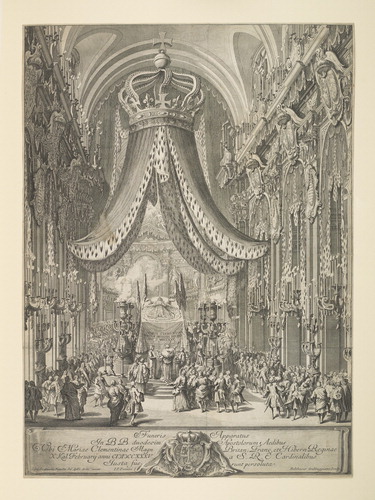
With these textual and visual sources, we can piece together the material experience of Clementina’s funeral. The ceremonies corresponded with the experience of other contemporary European monarchies, including her Stuart predecessors.Footnote46 It consisted of the three main stages common to royal funerals across Europe: the lying-in-state; the funeral procession; and the burial. During the funeral, Clementina’s body was ‘entangled in a web of symbols, images, and texts’.Footnote47 At each stage the use of royal iconography and ‘materials of magnificence’ such as velvet, gold thread, ermine and large quantities of black cloth to adorn Clementina’s body and the space around it, ensured that it was interpreted as a royal one. During the obsequies and procession, Clementina’s corpse was lain on a large catafalque, dressed in the English royal regalia, including crown and sceptre. For the lying-in-state and the burial however, she was dressed in the habit of the Dominican nuns. As previously noted, identifying Clementina as a nun did not necessarily conflict with contemporary understanding of queenship. At a time when funerals were used to ‘[underline] the unity of secular power and religious mission’ and monarchy was invested with divine authority, it was appropriate that in death queens were represented as saintly protectors of the faith.Footnote48 In addition to these material elements, inscriptions on banners around the church praised Clementina’s exemplary virtues: piety, charity, modesty, dignity.
These written and visual sources cannot, however, be considered as straightforward records of the ceremony. They are as much part of the image-making which surrounded Clementina in life and death as the events of the funeral itself. Despite the effort and expense that went into producing royal funerals — Clementina’s cost 20,000 scudi — they are ephemeral. The material symbols which during the ceremonies worked to proclaim the royal and virtuous identity of the deceased were replaced with published accounts, engravings and monuments. These were designed to share with the court’s subjects and fellow European monarchs the details of the funeral and its ‘iconographical programme’.Footnote49 The accounts provided ‘idealized versions’ of the ceremony, designed to add to the court’s ‘memoria’ in a display of its splendour and sovereignty.Footnote50 The Stuart court, assisted by the Papacy, was conscious to follow these conventions in its commemoration of Clementina. In death, Clementina’s identity continued to serve a purpose for the exiled Stuarts in securing their image as legitimate sovereigns.
James VIII/III understood the benefits of promoting Clementina’s memory and using the Parentalia to reaffirm relationships of loyalty between himself and his supporters. Shortly after its publication in December 1736, he wrote about the book to Lewis Innes at the Scots College in Paris. Innes was a significant figure in Jacobite networks and politics who had been almoner to Mary of Modena and James until 1718.Footnote51 James confided to Innes that, in keeping with the ceremonial and festive practices of crowned early-modern European monarchs, he expected the Parentalia to be widely circulated. The court sent copies to Paris for dissemination amongst supporters in France and from there to Britain.Footnote52 Innes and the College were gifted a decoratively bound version of the book: ‘the designs for you are the same that were given to me, & by consequence better bound, & so more fit to be kept in your college.’Footnote53 By gifting the book to the Scots College at Paris, the King not only shared the details of the funeral with his supporters there, but reinforced the relationship between the College and the Stuart dynasty, their Catholic monarchs and fellow exiles.
In addition to the funeral and its published accounts, monuments further enshrined Clementina’s memory in the realm of queenship. In 1735 Clementina’s body was buried in a tomb in the grottoes of Saint Peter’s Basilica, and her precordia, her organs, were placed within a monument in the church of Santi Apostoli, although a letter in the Stuart Papers suggests that James kept her heart in the private chapel of the Palazzo del Re for some time ().Footnote54 This monument was designed by Filippo della Valle on a grand scale, measuring about two metres, elevated and set within a pillar.Footnote55 Carved from marble, above the inscription to Clementina is an urn which contained her precordia. Two putti play around the urn, one holding up the flaming heart of Divine Love, the other leaning on the imperial crown placed upon the urn. Above them, three heads of putti float in the clouds, with rays of light shining down from Heaven onto the urn and Clementina’s holy remains inside it.
Figure 8 Monument to Maria Clementina Sobieska in SS XII Apostoli by Filippo della Valle, 1736. (Photo Georgia Vullinghs)
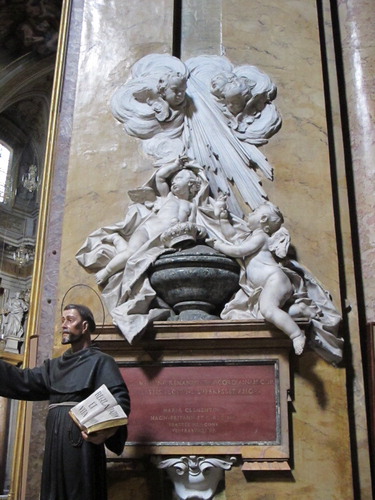
In 1739, a second monument was commissioned by Pope Clement XII for the interior of Saint Peter’s Basilica (). Designed by Filippo Barigioni, it was sculpted and completed by Pietro Bracci by 1742.Footnote56 In 1745 Clementina’s body was removed from the tomb in the grottoes to this more public site. This much larger sculpture, at several metres high, is situated between two pillars above a doorway in the left aisle of the Basilica near to the entrance. In keeping with Baroque queenship, it ‘screamed the royal status of Clementina’ and is on par with the scale of monuments to various popes nearby.Footnote57 This monument is also carved in marble and porphyry, materials commonly used in commemorative sculptures and the most ambitious architectural projects of the period. The design similarly includes putti who hold up royal regalia, symbols of her status, while a female figure representing Charity or Faith sits atop a sarcophagus, holding out the flaming heart of Divine Love. The pyramid behind the figure represents eternity, suggestive of the eternal place Clementina would find in Heaven. As objects which contained and represented the deceased person’s body, these two sculptures had the power to remind the viewer of Clementina’s absence, and simultaneously embody her presence. The shared iconography of the monuments continued to shape Clementina after death as an exemplary religious devotee and royal person. They signal her elevated position in life and its continuation in the afterlife, in Heaven and in the memory of those who remained on Earth.
Figure 9 Monument to Maria Clementina Sobieska in St Peter's Basilica, by Filippo Barigioni, Pietro Bracci and Pietro Paolo Cristofari, completed 1742. (Photo Georgia Vullinghs)
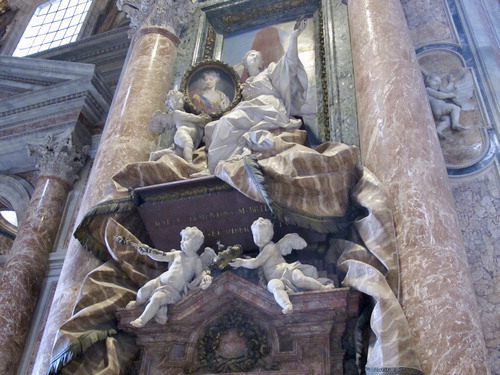
The Saint Peter’s monument includes the 1725 portrait of Clementina by Martin van Meytens, copied in mosaic by Pietro Paolo Cristofari. It is a continuation of the Stuart court’s fashioning of Clementina’s identity and was produced as a pair to James’ portrait. She is depicted with her head uncovered and hair powdered, wearing court dress, the sash of the Order of the Garter and jewels. Although Pope Benedict XIV ultimately agreed with James that Clementina should be identified as a queen, the choice of portrait initially caused some contention. Cardinal Lanfredini, who was in charge of decorations inside the Basilica, had argued that she should be portrayed ‘dressed as a penitent, as indeed the saintly princess actually was’.Footnote58 It is evident that in death, Clementina’s image and identity was contested and used by different factions for their own reasons.
It is worth noting that Clementina’s funeral, the Parentalia and the monuments built to her memory were all commissioned and paid for by Popes Clement XII and Benedict XIV. Traditionally, the funeral and its surrounding material have been understood as evidence of continued papal support for the Stuarts, with an emphasis on the extent to which Clementina as consort contributed to that favourable relationship.Footnote59 Edward Gregg has analysed the events and material culture of Clementina’s funeral as evidence that the Stuarts were considered ‘martyrs of the faith’, with emphasis on the central role Clementina’s religiosity played in the creation of that image.Footnote60 James himself interpreted the willingness of Clement XII to sponsor the funeral as confirmation of the Pope’s support for him, and consolidation of the Stuarts’ royal status in Rome.Footnote61 While this is a valid conclusion, the extent to which the Papacy appropriated Clementina’s posthumous reputation for its own means must be considered.
In the material culture surrounding Clementina’s death, these popes identified her as a particularly devout royal, the royal-nun the Queen fashioned herself in life. As previously noted, Clementina was dressed in the habit of the Dominican nuns for her burial, while the funeral procession largely consisted of members of religious orders. The account of Clementina’s life and death in the Parentalia is dominated by references to her piety and rejection of the material world. The iconography of the two funeral monuments celebrates Clementina’s spirituality and promised glory as a queen in Heaven. Manipulating the memory of Clementina as a saintly queen, these popes hoped to secure the memory of their own reigns as ‘golden ages’ of Christianity. This motive is explicitly stated in the Parentalia’s conclusion: ‘Even in the centuries to follow, we will remember how important faith and virtues were under the happy reign of Clement XII, so that the great deeds of them both [Clement and Clementina] will be shown by fathers to their sons, and by citizens to foreigners for them to remember.’Footnote62
The link between the Papacy and the memory of Clementina was further emphasised in a medal created by Benedict XIV to celebrate the completion of the monument to her (a and b). Produced in 1743, the obverse depicts a bust of the Pope and the reverse depicts the monument with the inscription MEMOIRAE.M.CLEM.M.BRIT.REGINAE (to the memory of Maria Clementina, Queen of Great Britain). This medal — a form of sculpture itself — and the monument it celebrates not only commemorate Clementina’s pious life but were designed to spread the message of Benedict’s actions. They glorify his reign, and emphasise his magnificence, as much as Clementina’s. Through the appropriation of Clementina’s image, these two popes carried out a personal programme of aggrandisement. By identifying Clementina as a pious queen, they could promote their individual power and that of the Roman Catholic church in Europe, which would be reinforced by a Stuart restoration in Britain.
Conclusion
Through an examination of the material and visual culture that surrounded her life and death, this article has moved towards a new historiography of Maria Clementina Sobieska and reinstated her as a central figure in the Stuart/Jacobite narrative. Furthermore, she has been placed within the history of Baroque queenship. Due to their unique situation as exiled monarchs, the Stuarts were conscious to identify themselves as royal, and to display the appropriate magnificence and virtues to their would-be subjects and supporters. As such they present a suitable case study for understanding the practices of early modern royal image-making. The case of Clementina’s queenship emphasises that the power of persuasion through representation did not exist in isolation. The making and manipulation of Clementina’s identity reveals that court ‘propaganda’ was part of a dialogue, in which monarch, court, sponsors, and subjects participated. The Stuart court, including Clementina herself, drew on precedent to fashion for their queen consort a recognisable image of Baroque queenship. The image created was, however, not static and singular. At a time of crisis, Clementina fashioned for herself an image which identified her with an alternative form of queenship. In doing so she gained more autonomy for herself, and exercised power as queen consort. After death, Clementina’s identity continued to be manipulated and contested as she was positioned as a holy queen.
Additional information
Notes on contributors
Georgia Vullinghs
Georgia Vullinghs
Georgia Vullinghs is an AHRC-funded PhD researcher with the University of Edinburgh and National Museums Scotland. Her thesis, ‘Loyal Exchange: The Material and Visual Culture of Jacobite Exile, c.1716–1760’, offers a cultural history of eighteenth-century Jacobitism, focussing on the experience of and responses to Stuart exile. Her wider research interests lie in eighteenth-century British cultural and social history.
Notes
1 Clarissa Campbell Orr, ‘Introduction’, in Clarissa Campbell Orr (ed.), Queenship in Europe 1660–1815: The Role of the Consort (Cambridge, 2004), pp. 1-15, p. 5.
2 Helen Watanabe-O’Kelly, ‘The Consort in the Theatre of Power: Maria Amalia of Saxony, Queen of the Two Sicilies, Queen of Spain’, in Helen Watanabe-O’Kelly and Adam Morton (eds), Queens Consort, Cultural Transfer and European Politics, c.1500–1800 (London, 2017), pp. 37-63, p. 37.
3 Helen Watanabe-O’Kelly, ‘Afterword: Queens Consort, Dynasty and Cultural Transfer’, in Watanabe-O’Kelly and Morton (eds), Queens Consort, pp. 231-250, p. 231.
4 Watanabe-O’Kelly, ‘The Consort in the Theatre of Power’, p. 57; Almut Bues, ‘Art Collections as Dynastic Tools: The Jagiellonian Princesses Katarzyna, Queen of Sweden, and Zofia, Duchess of Braunschweig-Wolfenbüttel’, in Watanabe-O’Kelly and Morton (eds), Queens Consort, pp. 15-36.
5 L. Granlund, ‘Queen Hedwig Eleonora of Sweden: Dowager, Builder, and Collector’, in Campbell Orr (ed.), Queenship in Europe, pp. 56-76, p. 71.
6 Charles W. Ingrao and Andrew L. Thomas, ‘Piety and Power: The Empress-Consort of the High Baroque’, in Campbell Orr (ed.), Queenship in Europe, pp. 107-130, pp. 110, 119.
7 Sybil Jack, ‘In Praise of Queens: The Public Presentation of the Virtuous Consort in Seventeenth-Century Britain’, in Stephanie Tarbin and Susan Broomhall (eds), Women, Identities and Communities in Early Modern Europe (Aldershot, 2008), pp. 211-224, p. 214.
8 Royal Archives, Stuart Papers [hereafter RA SP], Main series [hereafter Main], vol. 30 f.113, Charles Wogan to duke of Mar, Ohlau, April 1718; RA SP/Main/28 f.19, Wogan to Mar, Ohlau, 6 March 1718.
9 RA SP/Main/34 f.3, Marriage contract between James III and Princess Maria Clementina Sobieska, 22 July 1718.
10 Charles Wogan published his own account of the rescue a few years after the event: Charles Wogan, Female Fortitude, Exemplify’d, in an Impartial Narrative of the Seizure, Escape and Marriage, of the Princess Clementina Sobiesky As it was Particularly Set Down by Mr. Charles Wogan who was a Chief Manager in that Whole Affair (London, 1722). For a modern account of the episode see Peggy Miller, A Wife for the Pretender (London, 1965).
11 Neil Guthrie, The Material Culture of the Jacobites (Cambridge, 2013), p. 87.
12 Ibid.
13 Ibid.
14 Joanna Marshner, Queen Caroline: Cultural Politics at the Early Eighteenth-Century Court (New Haven, 2014), p. 18.
15 Joanna Woodall, ‘An Exemplary Consort: Antonis Mor’s Portrait of Mary Tudor’, Art History 14-2 (1991), pp. 192-224, p. 204.
16 Erin Griffey, On Display: Henrietta Maria and the Materials of Magnificence at the Stuart Court (London, 2015), p. 1.
17 Woodall, ‘An Exemplary Consort’, p. 217; Griffey, On Display, pp. 1, 29.
18 Woodall, ‘An Exemplary Consort’, pp. 208-10.
19 See Edward Corp, The King Over the Water: Portraits of the Stuarts in Exile after 1689 (Edinburgh, 2001), p. 63, fig. 45.
20 Maria Clementina Sobieska sitter file, Scottish National Portrait Gallery, S.Ph.III.59.85.
21 Woodall, ‘An Exemplary Consort’, p. 208.
22 Providing a language for understanding the roles of queens consort, Adam Morton summarises the contributions to the edited volume as revealing three potential categories: the queen as instrument manipulated by others; as agent of cultural/political influence; and as catalyst that allowed changes to happen around her. Adam Morton, ‘Introduction: Politics, Culture and Queens Consort’, in Watanabe-O’Kelly and Morton (eds.), Queens Consort, pp. 1-14, p. 3; see also in same volume, Elise Dermineur and Svante Norrhem, ‘Luise Ulrike of Prussia, Queen of Sweden, and the Search for Political Space’, pp. 84-108, p. 85.
23 RA SP/Miscellaneous [M]/Vol.32, Account Books, 23 March 1716 – c.7 April 1722.
24 RA SP/M/32 f.56.
25 RA SP/M/32 f.49.
26 Edward Corp, The Stuarts in Italy 1719–1766: A Royal Court in Permanent Exile (Cambridge, 2011). p. 28.
27 Corp, Stuarts in Italy, p. 165
28 Sir C. Petrie, ‘Introduction’ in J.T. Gilbert (ed.), Narratives of the Detention, Liberation, and Marriage of Maria Clementina Stuart, (Shannon, 1970), p. v.; A. Shields, Henry Stuart, Cardinal York and his times, (London, 1908), p. 3.
29 Aneta Markuszewska, ‘And all this because of “the weakness of your sex”: The Marital Vicissitudes of Maria Klementyna Sobieska Stuart, Wife of the Old Pretender to the English Throne’, in Almut Bues (ed.), Frictions and Failures: Cultural Encounters in Crisis (Wiesbaden, 2017), pp. 163-77; also Corp, Stuarts in Italy, chapters 7 and 8.
30 RA SP/Main/87 f.64, James III to Clementina, 9 November 1725.
31 Jennifer Germann, ‘Figuring Marie Leszczinska (1703–1768): Representing Queenship in Eighteenth-Century France’, PhD diss. University of North Carolina (Chapel Hill, 2002), p. 55.
32 Erin Griffey, ‘Henrietta Maria and the Politics of Widows’ Dress at the Stuart Court’, in Erin Griffey (ed.), Sartorial Politics in Early Modern Europe: Fashioning Women (Amsterdam, 2019), pp. 277-302, pp. 285-8; Isabelle Paresys, ‘Dressing the Queen at the French Renaissance Court: Sartorial Politics’, in Ibid., pp. 57-74, p. 66.
33 RA SP/Main/130 f.195, September 1729; RA SP/Main/134 f.115, February 1730; RA SP/Main/139 f.130, October 1730; RA SP/Main/170 f.149, May 1734.
34 RA SP/Main/87 f.83, An Account of Plate and other things Received from Mr McCarthy for the Queen’s use the 16th of November 1725.
35 RA SP/M/34 f.50, Account Books November 1722–April 1727.
36 RA SP/Main/130 f.109, August 1729.
37 RA SP/Main/132 f.182, September 1729; RA SP/Main/136 f.50, April 1730; RA SP/Main/170 f.149, May 1734; RA SP/Main/172 f.27, July 1734.
38 RA SP/Main/136 f.50, April 1730: paid the account of the cobbler for a pair of damask shoes with braid and doublers, 1.80 scudi; RA SP/Main/170 f.22, April 1734: 29 canes (measurement) of velvet, 68.40 scudi; RA SP/Main/170 f.149, May 1734: two lengths of Indian cotton, 2 scudi; ribbons, lace, white taffeta etc, 11.18 scudi.
39 RA SP/Main/130 f.109, August 1729; RA SP/Main/132 f.182, December 1729: Christmas donations to the chaplain of Our Lady of Loreto and to the sacristy of the same; to the chaplain of the Ursulines and factor of the same; to the Sacristy of Saint Cecilia and factors of the same; for a total of about 15 scudi; RA SP/Main/138 f.91, July 1730: paid by order of the Queen all the expenses which were made to repair the little church of the Madonna, including gilding two troughs, gilding two cabinets and one table, painting the two cabinets, floorboards, for washing the church etc., total 32-30 scudi; RA SP/Main/170 f.147, Expenses of the Queen for the dress of the Virgin of Loreto and a canopy given to the church of the Agonisants (another confraternity), 1734, including one cane of braided gold for the clothing of the Virgin, totalling 26.47 scudi.
40 Corp, Stuarts in Italy, p. 220.
41 RA SP/Main/177 f.167, Sister Mary Rosa Howard to James III, Brussels, 17 February 1735.
42 An Account of the Funeral Ceremonies perform’d at Rome, in Honour of the Princess Clementina Sobieski. Translated from the Roman Journal of Jan. 29, 1735. No 2729 (Dublin, 1735).
43 Cardinal Vincenzo Gotti, Parentalia Mariae Clementinae Magn. Britan. Franc., et Hibern .regin. issu Clementis XII. Pont. Max (Rome, 1736). With thanks to Ilaria Marchi for her translation of this text.
44 RA SP/Main/192 f.85, James III to Lewis Innes, Rome, 16 December 1736.
45 Corp, Stuarts in Italy, p. 221.
46 For other Stuart and British royal funerals, see Paul S. Fritz, ‘The Trade in Death: The Royal Funerals in England, 1685–1830’, Eighteenth-Century Studies 15-3, (1982), pp. 291-316; Michael Schaich, ‘The Funerals of the British Monarchy’, in Michael Schaich (ed.), Monarchy and Religion: The Transformation of Royal Culture in Eighteenth-Century Europe (Oxford, 2007), pp. 421-450, 424-6; for early-modern funeral apparati, see Minou Schraven, Festive Funerals in Early Modern Italy: The Art and Culture of Conspicuous Commemoration (Farnham, 2014), pp. 1-10.
47 Schaich, ‘Funerals of the British Monarchy’, p. 440.
48 Mark Hengerer, ‘The Funerals of the Habsburg Emperors in the Eighteenth Century’, in Schaich (ed.), Monarchy and Religion, pp. 367-93, p. 371; Mary II was presented as saintly during her funeral in order to further promote and consolidate the values of the Glorious Revolution, Schaich, ‘Funerals of the British Monarchy’, p. 441.
49 Schraven, Festive Funerals, p. 2.
50 Schraven, Festive Funerals, p. 3; Helen Watanabe-O’Kelly, ‘Early Modern European Festivals: Politics and Performance, Event and Record’, in J.R. Mulryne and Elizabeth Goldring (eds), Court Festivals of the European Renaissance: Arts, Politics and Performance (Aldershot, 2002), pp. 15-25, pp. 19-23.
51 James F. McMillan, ‘Innes, Lewis (1651–1738), Roman Catholic Priest and Courtier’, Oxford Dictionary of National Biography (Oxford, 2004). Consulted online, https://doi.org/10.1093/ref:odnb/14431.
52 RA SP/Main/192 f.34, James Edgar to Innes, 5 December 1736 (James Edgar was Secretary to the court 1728–62).
53 RA SP/Main/192 f.34, James Edgar to Innes, 5 December 1736; RA SP/Main/192 f.85, James III to Innes, Rome, 16 December 1736.
54 RA SP/Main/191 f.90, James III to Innes, Rome, 11 November 1736.
55 Antonio Pinelli (ed.), The Basilica of St Peter in the Vatican, vol. 4 Testi 2 Schede (Modena, 2000), p. 530.
56 Ibid, p. 529.
57 Edward Gregg, ‘Monarchs without a Crown’, in Robert Oresko, G.C. Gibbs and H.M. Scott (eds), Royal and Republican Sovereignty in Early Modern Europe: Essays in Memory of Ragnhild Hatton (Cambridge, 1997), pp. 382-422, p. 419.
58 Corp, Stuarts in Italy, p. 228.
59 Edward Corp, ‘The Extended Exile of James III’, in Philip Mansel and Torsten Riotte (eds), Monarchy and Exile: The Politics of Legitimacy from Marie de Médicis to Wilhelm II (Basingstoke, 2011), pp. 165-177, p. 170; Corp, Stuarts in Italy, pp. 221, 228.
60 Edward Gregg, ‘The Exiled Stuarts: Martyrs for the Faith?’, in Schaich (ed.), Monarchy and Religion, pp. 187-213, pp. 202ff; Gregg, ‘Monarchs without a Crown’, p. 404.
61 RA SP/Main/177 f.24, James III to Colonel O’Brien, Rome, 19 January 1735.
62 Parentalia, p. 30: ‘pur non ostante a’ secoli, che verranno faràperpetua fede in quanto pregio, e riverenza si tenesse la virtùsotto il felicissimo refno di Clemente XII. E mostrandolo i Padri a’ figliuoli, i cittadini agli esteri; le gloriose gesta dell’uno, e dell’altra andranno rammemorando.’

